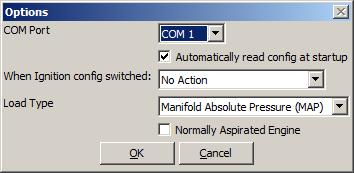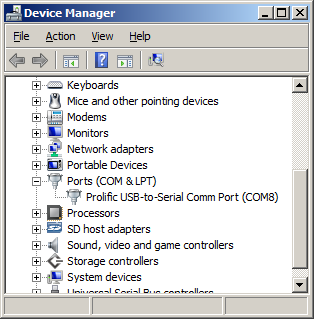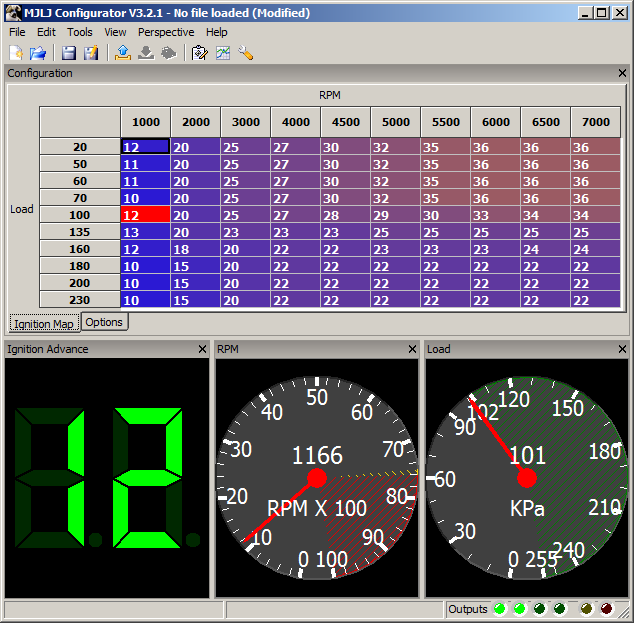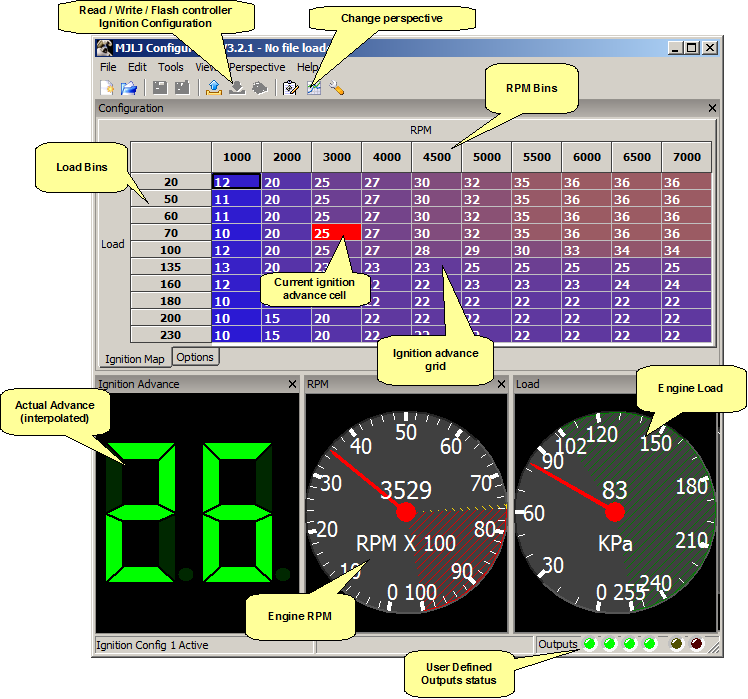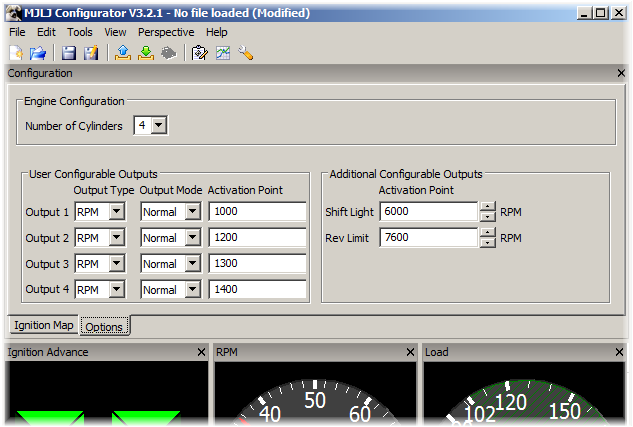MJLJ V3 Operation Guide
This is a work in progress. Please check back soon!
First time use
Installing Configuration Software
Download the version of the Configuration software that matches your controller firmware. It's likely you have a very recent firmware image, so start by downloading the latest version of the Configuration software.
Setting the Serial Port
Find and run the Configuration software by finding the icon under the Start Menu program group. Once the program is running, you can set the serial port the MJLJ is connected to by clicking Tools/Configurator Options.
If you don't know which COM port you have the MJLJ connected to, you can discover this under Windows Device Manager: Find the 'My Computer' icon, right-click and select Properties. From this window you will be able to access Device Manager.
Expand the 'Ports (COM & LPT)' to see the list of installed COM ports.
Once you're certain which COM port you're using for the MJLJ, select this value in the options dialog.
Configuring MAP or TPS
In the Controller Options dialog, select the Load type you have for your MJLJ- Throttle Position sensor(TPS) or Manifold Absolute Pressure (MAP).
Configuring Normally Aspirated or Forced Induction
Check the 'Normally Aspirated' box if that matches your engine type. This setting will scale the load axis for the runtime and logging views to 103KPa maximum.
Otherwise, select 'Forced Induction' if your engine is turbocharged or supercharged. This will set the maximum scale to 255KPa (about 21 PSI of boost)
Connecting to the MJLJ
Verifying Connectivity
After the COM port has beens et, connect the serial cable to the MJLJ and apply power. If you already have the MJLJ wired into your engine's wiring harness, turn the ignition key to 'on'. If you are testing the MJLJ on the bench, you can simply power the unit with a 9V battery or a suitable 9-15V power supply.
The first way to verify connectivity is to observe runtime data on the screen. On a running engine you'll see the real-time RPM, load and ignition advance values on the gauges at the bottom of the window.
If you're testing on the bench or on a non-running engine, you will still be able to observe some runtime activity by simulating load changing on the engine. For TPS- move the accelerator pedal; MAP- you can manually apply pressure or vacuum.
Common connection problems
If the Configuration Software cannot connect to the MJLJ, you will see one of the following messages in the status bar:
Timeout reading runtime data
The Configuration Software did not get a response from the MJLJ on the serial port you specified.
- Does the MJLJ have power, and connected to the computer with a standard serial cable or compatible USB-Serial adapter?
Could not open port
The Configuration Software could not access the serial port you specified.
Either:
- The port is invalid: Check Device Manager for the proper serial port.
- Serial port in use: If another program is using the same serial port your computer will block the Configuration software from accessing the serial port. Check that you don't have any other software which may open and use the serial port you're trying to use, such as PDA sync software.
Monitoring Engine Runtime
Working with the Ignition Configuration
Retrieving the Ignition Configuration
To read the controller's current configuration, click the toolbar icon ![]() . The current ignition configuration will be read from the MJLJ and displayed in the grid.
. The current ignition configuration will be read from the MJLJ and displayed in the grid.
Ignition Map
The ignition map organized as a 10 x 10 grid of ignition advance values, with Load/RPM bins defining the steps between grid values.
- Load Axis: The Load axis is is represented vertically, from low engine load at the top to high engine load at the bottom.
- RPM Axis: The RPM axis is represented horizontally, from low RPM on the left to high RPM on the right.
- Bins: The steps between engine load and RPM points are defined as 'Bins'- these are the values shown along the borders of the Ignition Map grid.
- Ignition Advance: Each cell in the grid represents an ignition advance value, in actual degrees before top dead center (BTDC).
Editing Ignition Map
Adjusting ignition advance
- Changing single value
To change an ignition advance value, click in the cell you wish to change- the cell will change to editing mode and allow you to change the value.

- Changing multiple cells
To change multiple cells at once, select a region of cells much like you would with a spreadsheet program. You can select contiguous regions by clicking and dragging, or select individual cells cells by holding down the control key while clicking.
Once you've selected the cells you wish to change, right click the selected group and select 'Set Value'. A dialog will pop up and prompt for the new value.
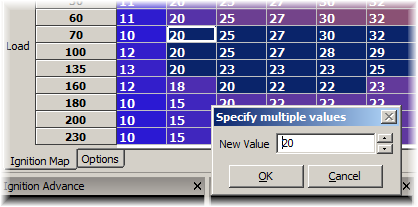
- Valid Ignition Advance range: You are able to set individual cells from 0 to 59 degrees BTDC.
Adjusting Load / RPM Bins
To change the Load and RPM bins perform one of the following:
- Click the 'Edit' menu and select'Edit RPM and Load bins'
- Ctrl-B in the main window
- Right click on the Load or RPM bins in the grid and select 'Edit RPM and Load Bins'
The Edit Ignition Bin values dialog will appear. Here, you can edit the bin values for the Load and RPM axis.

Edit the values and click 'OK' to confirm your changes.
Controller Options
To access the various MJLJ controller options, click the 'Options' tab below the ignition grid.
Engine Configuration
Select the number of cylinders for your engine (4,6 or 8 cylinders), matching the EDIS module you are using.
User Configurable Outputs
The Megajolt Lite Jr. offers four identical configurable outputs, each with customizable activation.
Output Type
- Load: Select this type to activate on a Load threshold.
- RPM: Select this type to activate on an RPM threshold.
Output Mode
- Normal: The output will be enabled at or above the set activation point and disabled below set activation point.
- Invert: The output will be disabled at or above the set activation point and enabled below the activation point.
Activation Point
The RPM or Load threshold for activating the output.
Hysteresis on outputs
- RPM configured outputs: Hysteresis is set at 100RPMs.
- Load configured outputs: Hysteresis is set at 1 load unit (MAP KPa or TPS %).
For wiring instructions on the User Configurable Outputs, see the Installation Guide.
Shift Light
The Shift Light output is activated when engine RPM reaches the configured threshold. Typically this output would be used to illuminate a dashboard-mounted light. For shift light wiring instructions, see the Installation Guide.
Rev Limit
The Rev Limit output is an RPM switch with special behavior.
- At the specified RPM threshold, the Rev Limit output is activated and can be used to trigger an external Rev Limiter module, such as the Autosport Labs Hard Rev Limiter
- 100 RPMs before threshold the ignition advance goes to zero BTDC to act as a 'soft' rev limiter by significantly reducing engine power. Together with an external hard rev limit module this provides an effective rev-limit solution, naturally excluding mechanical over-rev situations.
For instructions on wiring an external rev limit module, see the Installation Guide.

